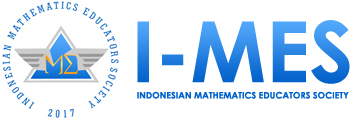The Enhancement of Students Mathematical Communication Ability Through RME-Textbook
DOI:
https://doi.org/10.35706/sjme.v5i1.4412Abstract
This study was a research and development used ADDIE model aimed to produce mathematics textbook for 8th-grade students by applying five principles of the Realistic Mathematics Education (RME) approach, included: phenomenological exploration, bridging by vertical instruments, self-reliance with students own constructions and productions, interactivity, and intertwining. The subject in this study involved 30 students' junior high school in Yogyakarta. The qualities of the developed textbook refer to three criteria, namely validity, practicality, and effectiveness. Supporting instruments used to examine three criteria for the quality of the textbook were validation sheets, assessment sheets for teachers and students, and students' mathematical communication ability test. The textbook meets the criteria of validity, practicality, and effectiveness if at least "good" from the results of validator assessments, the results analysis from teachers and student assessments, and at least 75% of the students' mathematical communication ability test results. Based on the results of this study, the developed textbook has met the criteria of validity (very good), practicality (very good by the teacher and good by students), and effectiveness (good for 86.67%). Therefore, developing textbooks is suitable to use as an alternative to enhance the students' mathematical communication ability.
Downloads
References
Anggraini, R. S., & Fuzan, A. (2018). The Influence of Realistic Mathematics Education (RME) Approach on Students’ Mathematical Communication Ability. 285, 208–210.
Asmida. (2011). Meningkatkan kemampuan penalaran dan komunikasi matematis siswa sekolah menengah pertama melalui pendekatan realistik. Tesis Magister, tidak diterbitkan. Universitas Pendidikan Indonesia, Bandung.
Branch, R. M. (2009). Instructional Design: The ADDIE Approach. New York: Springer Science+Business Media, LLC.
Depdiknas. (2008). Panduan Pengembangan Bahan Ajar. Jakarta.
Gravemeijer, K. (2010). Realistic Mathematics Education Theory as a Guideline for Problem-Centered, Interactive Mathematics Education. In R. K. Sembiring, K. Hoogland, & M. Dolk (Eds.), A Decade of PMRI in Indonesia (pp. 41–50). Bandung.
Habsah, F. (2017). Developing teaching material based on realistic mathematics andoriented to the mathematical reasoning and mathematical communication. Jurnal Riset Pendidikan Matematika, 4(1), 43.
Johar, R. (2010). Pendekatan Matematika Realistik Indonesia (PMRI) dan Relevansinya dengan KTSP. Seminar Matematika Universitas Serambi Mekkah 7 Jaunari 2010, pp. 1–8. Aceh.
Lestari, K. E., & Yudhanegara, M. R. (2017). Penelitian Pendidikan Matematika. Bandung: PT Refika Aditama.
Lomibao, L. S., Luna, C. A., & Namoco, R. A. (2016). The influence of mathematical communication on students’ mathematics performance and anxiety. American Journal of Educational Research, 4(5), 378–382.
Nicol, C. C., & Crespo, S. M. (2006). Learning to Teach with Mathematics Textbooks: How Preservice Teachers Interpret and Use Curriculum Materials. Educational Studies in Mathematics, 62, 331–355.
Nieveen, N. (1999). Prototyping to Reach Product Quality. In J. van den Akker, R. M. Branch, K. Gustafson, N. Nieveen, & T. Plomp (Eds.), Design Approaches and Tools in Education and Training (pp. 125–136). Dordrecht: Springer-Science+Business Media, B.V.
NTCM. (2000). Principle and Standards for School Mathematics. Reston: NTCM, Inc.
OECD. (2016). PISA 2015 Results in Focus. Retrieved from www.oecd.org/pisa.
Republik Indonesia. (2007). Undang-Undang Republik Indonesia Nomor 16 Tahun 2007 tentang Standar Kualifikasi Akademik dan Kompetensi Guru.
Republik Indonesia. (2016). Undang-Undang Republik Indonesia Nomor 21 Tahun 2016 tentang Standar Isi Pendidikan Dasar dan Menengah.
Reys, B. J., Reys, R. E., & Chavez, O. (2004). Why Mathematics Textbook Matter. Educational Leadership, 61–66.
Treffers, A. (1987). Three Dimensions: A Model of Goal and Theory Description in Mathematics Instruction – The Wiskobas Project. Dordrecht: D. Reidel Publishing Company.
Trisnawati, T., Pratiwi, R., & Waziana, W. (2018). The effect of realistic mathematics education on student’s mathematical communication ability. Malikussaleh Journal of Mathematics Learning (MJML), 1(1), 31.
Vale, I., & Barbosa, A. (2017). The Importance of Seeing in Mathematics Communication. Journal of the European Teacher Education Network, 12, 49–63.
Van de Walle, J. A., Karp, K. S., & Bay-Williams, J. M. (2013). Elementary and Middle School Mathematics: Teaching Developmentally (8th Ed). Boston: Pearson.
Widoyoko, E. P. (2017). Evaluasi program pembelajaran panduan praktis bagi pendidik dan calon pendidik. Yogyakarta: Pustaka Pelajar.
Wijaya, A., van den Heuvel-Panhuizen, M., & Doorman, M. (2015). Opportunity-to-learn context-based tasks provided by mathematics textbooks. Educational Studies in Mathematics, 89(1), 41–65.
Yang, D.-C., Tseng, Y.-K., & Wang, T.-L. (2017). A comparison of geometry problems in middle-grade mathematics textbooks from Taiwan, Singapore, Finland, and the United States. Eurasia Journal of Mathematics, Science and Technology Education, 13(7), 2841–2857.
Zaini, A., & Marsigit. (2014). Perbandingan Keefektifan Pembelajaran Matematika dengan Pendekatan Matematika Realistik dan Konvensional ditinjau dari Kemampuan Penalaran dan Komunikasi Matematik Siswa. Jurnal Riset Pendidikan Matematika, 1(2), 152–163.
Downloads
Published
Versions
- 2021-03-19 (2)
- 2021-01-29 (1)
How to Cite
Issue
Section
License

This work is licensed under a Creative Commons Attribution-ShareAlike 4.0 International License.
Authors who publish with this journal agree to the following terms:
- Authors retain copyright and grant the journal right of first publication with the work simultaneously licensed under a Creative Commons Attribution License that allows others to share the work with an acknowledgment of the work's authorship and initial publication in this journal.
- Authors are able to enter into separate, additional contractual arrangements for the non-exclusive distribution of the journal's published version of the work (e.g., post it to an institutional repository or publish it in a book), with an acknowledgment of its initial publication in this journal.
- Authors are permitted and encouraged to post their work online (e.g., in institutional repositories or on their website) prior to and during the submission process, as it can lead to productive exchanges, as well as earlier and greater citation of published work (See The Effect of Open Access).











